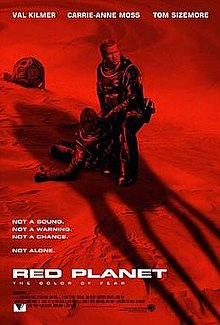
Mars, the fourth planet from the Sun, has appeared as a setting in works of fiction since at least the mid-1600s. Trends in the planet's portrayal have largely been influenced by advances in planetary science. It became the most popular celestial object in fiction in the late 1800s, when it became clear that there was no life on the Moon. The predominant genre depicting Mars at the time was utopian fiction. Around the same time, the mistaken belief that there are canals on Mars emerged and made its way into fiction, popularized by Percival Lowell's speculations of an ancient civilization having constructed them. The War of the Worlds, H. G. Wells's novel about an alien invasion of Earth by sinister Martians, was published in 1897 and went on to have a major influence on the science fiction genre.

Robert Zubrin is an American aerospace engineer, author, and advocate for human exploration of Mars. He is also an advocate for U.S. space superiority, writing that "in the 21st century, victory on land, sea or in the air will go to the power that controls space." and that "if we desire peace on Earth, we need to prepare for war in space."
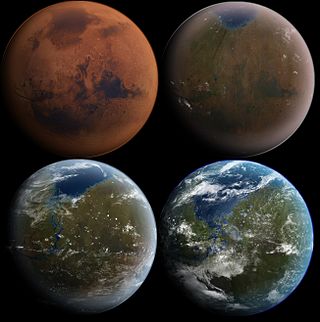
Terraforming or terraformation ("Earth-shaping") is the hypothetical process of deliberately modifying the atmosphere, temperature, surface topography or ecology of a planet, moon, or other body to be similar to the environment of Earth to make it habitable for humans to live on.
Red Planet is a nickname for the planet Mars, due to its surface color. It may also refer to:

Val Edward Kilmer is an American actor. Originally a stage actor, he found fame after appearances in comedy films, starting with Top Secret! (1984) and Real Genius (1985), as well as the military action film Top Gun (1986) and the fantasy film Willow (1988). Kilmer gained acclaim for his portrayal of Jim Morrison in Oliver Stone's The Doors (1991). He was cast as a main character in critically acclaimed films such as the western Tombstone (1993), and the crime dramas True Romance (1993) and Heat (1995). He portrayed Batman in Joel Schumacher's Batman Forever (1995), and continued to star in films such as The Ghost and the Darkness (1996), The Saint (1997), The Prince of Egypt (1998), Alexander (2004), Kiss Kiss Bang Bang (2005), and The Snowman (2017). In 2022, Kilmer reprised his role as Iceman in Top Gun: Maverick (2022).
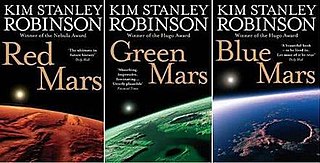
The Mars trilogy is a series of science fiction novels by Kim Stanley Robinson that chronicles the settlement and terraforming of the planet Mars through the personal and detailed viewpoints of a wide variety of characters spanning almost two centuries. Ultimately more utopian than dystopian, the story focuses on egalitarian, sociological, and scientific advances made on Mars, while Earth suffers from overpopulation and ecological disaster.
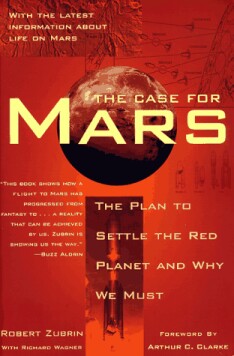
The Case for Mars: The Plan to Settle the Red Planet and Why We Must is a nonfiction science book by Robert Zubrin, first published in 1996, and revised and updated in 2011.

Thomas Edward Sizemore Jr. was an American actor. Born in Detroit, Michigan, he started his career with supporting appearances in Born on the Fourth of July (1989), Lock Up (1989), and Blue Steel (1990). These appearances led to more prominent roles in films like Passenger 57 (1992), True Romance (1993), Striking Distance (1993), Natural Born Killers (1994), Strange Days (1995), Heat (1995), and The Relic (1997).

The Ghost and the Darkness is a 1996 American historical adventure film directed by Stephen Hopkins and starring Val Kilmer and Michael Douglas. The screenplay, written by William Goldman, is a fictionalized account of the Tsavo man-eaters, a pair of male lions that terrorized workers in and around Tsavo, Kenya during the building of the Uganda-Mombasa Railway in East Africa in 1898.

Tombstone is a 1993 American Western film directed by George P. Cosmatos, written by Kevin Jarre, and starring Kurt Russell and Val Kilmer, with Sam Elliott, Bill Paxton, Powers Boothe, Michael Biehn, and Dana Delany in supporting roles, as well as narration by Robert Mitchum.
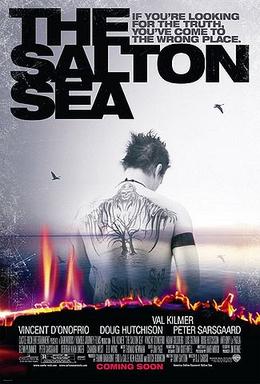
The Salton Sea is a 2002 American neo-noir crime thriller film directed by D. J. Caruso and starring Val Kilmer and Vincent D'Onofrio.

The planet Venus has been used as a setting in fiction since before the 19th century. Its opaque cloud cover gave science fiction writers free rein to speculate on conditions at its surface—a "cosmic Rorschach test", in the words of science fiction author Stephen L. Gillett. The planet was often depicted as warmer than Earth but still habitable by humans. Depictions of Venus as a lush, verdant paradise, an oceanic planet, or fetid swampland, often inhabited by dinosaur-like beasts or other monsters, became common in early pulp science fiction, particularly between the 1930s and 1950s. Some other stories portrayed it as a desert, or invented more exotic settings. The absence of a common vision resulted in Venus not developing a coherent fictional mythology, in contrast to the image of Mars in fiction.

The terraforming of Mars or the terraformation of Mars is a hypothetical procedure that would consist of a planetary engineering project or concurrent projects aspiring to transform Mars from a planet hostile to terrestrial life to one that could sustainably host humans and other lifeforms free of protection or mediation. The process would involve the modification of the planet's extant climate, atmosphere, and surface through a variety of resource-intensive initiatives, as well as the installation of a novel ecological system or systems.
A flag of Mars is a concept of a possible flag design, meant to symbolize the planet Mars or to represent a fictional Martian government, in works of fiction.

In space exploration, in situ resource utilization (ISRU) is the practice of collection, processing, storing and use of materials found or manufactured on other astronomical objects that replace materials that would otherwise be brought from Earth.

A harmful algal bloom (HAB), or excessive algae growth, is an algal bloom that causes negative impacts to other organisms by production of natural algae-produced toxins, mechanical damage to other organisms, or by other means. HABs are sometimes defined as only those algal blooms that produce toxins, and sometimes as any algal bloom that can result in severely lower oxygen levels in natural waters, killing organisms in marine or fresh waters. Blooms can last from a few days to many months. After the bloom dies, the microbes that decompose the dead algae use up more of the oxygen, generating a "dead zone" which can cause fish die-offs. When these zones cover a large area for an extended period of time, neither fish nor plants are able to survive. Harmful algal blooms in marine environments are often called "red tides".

The Mars Oxygen In-Situ Resource Utilization Experiment (MOXIE) was a technology demonstration on the NASA Mars 2020 rover Perseverance investigating the production of oxygen on Mars. On April 20, 2021, MOXIE produced oxygen from carbon dioxide in the Martian atmosphere by using solid oxide electrolysis. This was the first experimental extraction of a natural resource from another planet for human use. The technology may be scaled up for use in a human mission to the planet to provide breathable oxygen, oxidizer, and propellant; water may also be produced by combining the produced oxygen with hydrogen.

Terra Formars is a 2016 Japanese science fiction film directed by Takashi Miike and based on the manga series of the same name by Yū Sasuga & Kenichi Tachibana. It was released in Japan on Friday, April 29, 2016.

Terraforming Mars is a board game for 1 to 5 players designed by Jacob Fryxelius and published by FryxGames in 2016, and thereafter by 12 others, including Stronghold Games. In Terraforming Mars, players take the role of corporations working together to terraform the planet Mars by raising the temperature, adding oxygen to the atmosphere, covering the planet's surface with water and creating plant and animal life. The game incorporates elements of resource management, engine building, and strategic planning. Players compete to earn the most victory points, which are measured by their contribution to terraforming and to human infrastructure. These goals are achieved by collecting income and resources which allow them to play various projects, represented by cards that increase their income or resources, build infrastructure, or directly contribute to terraforming the planet. The game was received positively by fans and critics, and received numerous awards.
